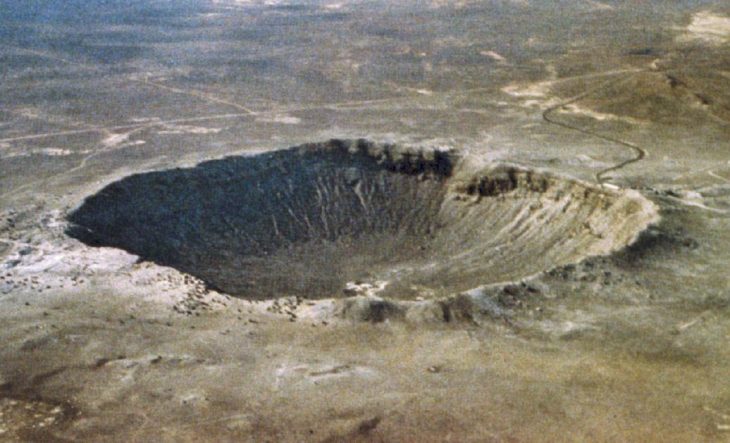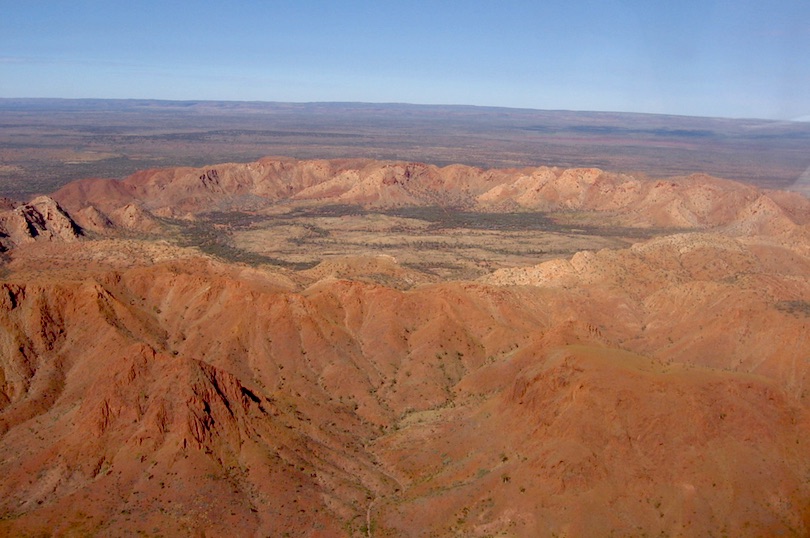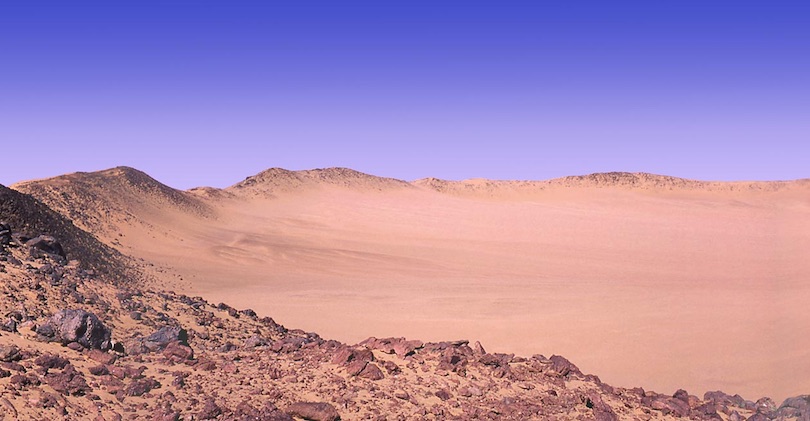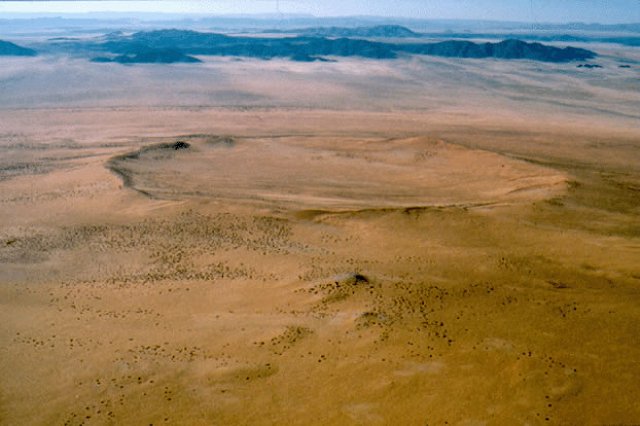Still, right around 170 earthbound effect pits have been distinguished on our planet. These range in width from a couple of several meters up to around 300 km (186 miles), and they run in age from late circumstances to more than two billion years. The effect pits included on this rundown are moderately little and youthful making them less demanding to spot. A case of a substantial and old effect cavity is the Chicxulub cavity with a distance across of 180 kilometers (110 miles). The effect that shaped this acclaimed cavity is thought to have been in charge of the termination of the dinosaurs, around 65 million years prior. Check out the fascinating impact craters on earth.
Fascinating Impact Craters on Earth
Roter Kamm Crater
Situated in the Namib Desert, Namibia, the Roter Kamm cavity is around 2.5 km (1.6 miles) in distance across and is 130 meters (400 feet) profound. It was made by a meteor with a size of a substantial vehicle around 3.7 million years back. The pit is unmistakably noticeable, yet its floor is secured by sand stores no less than 100 meters (300 feet) thick. Joined with the orangey-red shade of the Namib Desert the hole gives the impression of a Martian surface as opposed to that of our own planet.
Kaali Crater
The Kaali Crater was made by a shooting star that achieved the earth somewhere close to the fourth and eighth century BC. At an elevation of around 5-10 km, the shooting star broke into pieces and tumbled to the Earth in sections. The biggest hole is around 110 meters wide and 22 meters profound. Inside a 1 kilometer sweep of the fundamental pit lie 8 littler pits that were made amid this barrage. The whole woodland of the Estonian island of Saaremaa in all likelihood torched accordingly of the effect. The cavity is a piece of numerous Estonian myths and stories. It is even conceivable that Saaremaa was the amazing Thule island, though the name “Thule” could have been associated with the Finnish word tule.
Tenoumer Crater
Almost an impeccable circle, the Tenoumer Crater is 1.9 kilometers (1.2 miles) wide, and sports an edge 100 meters (330 feet) high. The cavity is situated in the western Sahara Desert, Mauritania. Present day geologists since quite a while ago faced off regarding what created this hole, some of them supporting a spring of gushing lava. However, nearer examination of the structure uncovered that the hole’s solidified “magma” was really shake that had softened from a shooting star affect. This effect happened generally in the vicinity of 10,000 and 30,000 years prior.
Lonar Crater Lake
The Lonar Lake in Maharashtra, was framed around 50,000 years prior when a shooting star hit the surface. The saltwater lake that developed in the subsequent basaltic shake arrangement has a mean width of 1.2 kilometers (3,900 feet) and is around 137 meters (449 feet) beneath the cavity edge. Various sanctuaries encompass the lake, the greater part of which are in vestiges, with the exception of a sanctuary of Daityasudan, at the focal point of the Lonar town, which was inherent respect of Vishnu’s triumph over the mammoth Lonasur. The pit itself is a fun trek and the encompassing vegetation is a treat for birdwatchers.
Monturaqui Crater
The Monturaqui Crater is found south of the Salar de Atacama in Chile. The present measurements of the cavity are roughly 460 meter (1,509 feet) in distance across by 34 meter (100 feet) profound. The effect most likely happened around a million years back. Due to the extraordinary dry states of the zone the cavity is still plainly unmistakable. By its size and morphology, the Monturaqui pit presents numerous likenesses with the Bonneville pit on Mars investigated by the Spirit meanderer in 2004. Both holes are shallow, the measure of the pieces catapulted close to the pit edge are comparable, and both were framed in a volcanic situation.
Gosses Bluff Crater
Situated close to the center point of Australia, the Gosses Bluff hole is thought to have been shaped by the effect of a space rock or comet around 142 million years prior. The dissolved cavity is 6 km (4 miles) over, yet at the season of effect it would have been around 22 km (14 miles) in distance across. The site is known as Tnorala toward the Western Arrernte Aboriginal individuals, and is a consecrated place.
Tswaing Crater
The Tswaing Crater was made by a chondrite or stony shooting star, approximately 30 to 50 meter in measurement, that hit the earth around 220,000 years back. In the focal point of the cavity is a little lake which is filled by a spring and water. Stone instruments from the stone age demonstrate that the pit was routinely gone by individuals keeping in mind the end goal to chase and gather salt. European pioneers named the district Zoutpan (Salt Pan) while the nearby Tswana tribes call the locale Tswaing which signifies “Place of Salt”.
Pingualuit Crater
The Pingualuit Crater was made around 1.4 million years back by a shooting star affect that had the constrain of 8500 Hiroshima-sized nuclear bombs. The 3.44 km (2.14 miles) measurement hole rises 160 meters (520 feet) over the encompassing tundra and is 400 meter (1,300 feet) profound. The lake at the base of the pit has a profundity of 270 meter (890 feet) and contains a portion of the purest water on the planet. The lake has no deltas or obvious outlets, so the water amasses from rain and snow and is just lost through dissipation. The hole was found in 1943, by a US Air Force plane on a meteorological flight. Pingualuit signifies “where the land ascends” in the nearby Inuit dialect.
Amguid Crater
The flawlessly roundabout shooting star affect pit is 450 meter (1476 feet) in width and 30 meter (100 feet) profound. The highest point of the edge is secured by squares of sandstones that are a few meters in measurement. The center point of the pit is level, and is filled by compacted eolian residues.
Wolfe Creek Crater
The Wolfe Creek Crater in Australia was framed by a shooting star that collided with the earth 300,000 years back. The 50,000 had a mass of around 50,000 tons and left a hole of around 875 meters (2870 feet) in breadth. The cavity that was left was presumably around 120 meters profound. Throughout the following 300,000 years the twist step by step filled it with sand and today the pit floor is 60 meters (200 feet) beneath the edge, which rises 25 meters over the encompassing level forsake arrive. Little quantities of iron shooting stars have been found in the region of the hole. The hole was found amid an aeronautical overview in 1947 in spite of the fact that the Aboriginal individuals have known the hole for a large number of years.
Barringer Crater
Barringer Crater is the best known and best protected effect pit on Earth. The hole is named after Daniel Barringer who was first to propose that it was created by a shooting star affect. The pit is still exclusive by his family and is additionally basically known as Meteor Crater or Arizona Crater. Measuring around 1,200 meters (4,000 feet) in distance across and 170 meters (570 feet) profound, with an edge 45 meter higher by and large than the encompassing plain, the hole lies close Flagstaff, Arizona. The Barringer Crater was framed around 40,000 years back by the effect of an iron shooting star, somewhere in the range of 50 meters (54 yards) crosswise over and measuring a few hundred thousand tons. Late research recommends that the meteor struck at a speed of 12.8 kilometers for each second (28,600 mph).
Enjoy!





